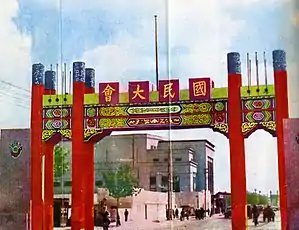National Assembly (Republic of China)
The National Assembly (Chinese: 國民大會; pinyin: Guómín Dàhuì; Wade–Giles: Kuo²-min² Ta⁴-hui⁴; Pe̍h-ōe-jī: Kok-bîn Tāi-hōe; Zhuyin Fuhao: ㄍㄨㄛˊ ㄇㄧㄣˊ ㄉㄚˋ ㄏㄨㄟˋ) was the authoritative legislative body of the Republic of China, commonly known as Taiwan after 1949. It was established under the 1947 Constitution of the Republic of China as a constitutional convention and electoral college to elect the President and Vice President.
National Assembly 國民大會 | |
|---|---|
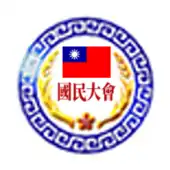 | |
| Type | |
| Type | |
| History | |
| Founded | March 29, 1948 |
| Disbanded | June 7, 2005 |
| Preceded by | Nationalist government |
| Succeeded by |
|
| Structure | |
| Seats | 1st: 2961 (in 1948) → 668 (in 1990) 2nd: 325 3rd: 334 ad hoc: 300 |
Length of term | 1st: 1948–1991 2nd: 1992–1995 3rd: 1996–2000 ad hoc: 2005 (1 month) |
| Elections | |
| |
First general election | November 21, 1947 |
Last general election | May 14, 2005 |
Next general election | N/A (defunct) [1] |
| Meeting place | |
| National Great Hall, Nanking (1948) Zhongshan Hall, Taipei (1954–1966) Chung-Shan Building, Taipei (1966–2005) | |
| Constitution | |
| Constitution of the Republic of China Additional Articles of the Constitution | |
The first National Assembly was elected in November 1947 and met in Nanking in March 1948. However, in the next year, the Kuomintang-led government of the Republic of China lost mainland China in the Chinese Civil War and retreated to Taiwan. The National Assembly resumed its meeting in Taipei in 1954. In the 1990s, its parliamentary powers were gradually transferred to the Legislative Yuan and direct democracy exercised by the Taiwanese people before constitutional amendments made it a dormant body in 2000 and fully defunct in 2005.
History
Early Republican period
Calls for a National Assembly were part of the platform of the revolutionaries who ultimately overthrew the Qing dynasty. In response, the Qing dynasty formed the first assembly in 1910, but it was virtually powerless and intended only as an advisory body. In the early Republican Era, the bicameral National Assembly was established by the Beiyang government. The design referred the structure of the United States Congress as Senate (參議院) and House of Representative (眾議院). However, the Warlord Era with the interference of military power toward the constitution suppressed the authority and the reputation of the National Assembly.
1947 Constitution
In 1946, the Constituent Assembly promulgated a new constitution and the first National Assembly met in 1948 in Nanjing, the Chinese capital. Shortly afterwards in 1949, mainland China fell to the Communists in the Chinese Civil War, and the National Assembly (along with the entire ROC government) was relocated to Taipei. Apart from the KMT, the only legal parties were the Democratic Socialist Party and the Youth Party.
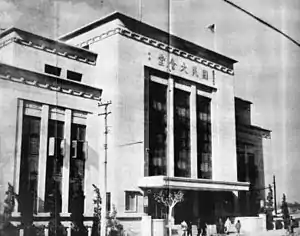 National Assembly Building in Nanking, the meeting place of the first sesion of the first National Assembly in 1948 |
Under the constitution, the main duty of the National Assembly was to elect the President and Vice President for terms of six years. It also had the right to recall or impeach the President and Vice President if they failed to fulfill their political responsibilities. According to "National Assembly Duties Act," the National Assembly could amend the constitution with a two-thirds majority, with at least three-quarters membership present, as well as to ratify constitutional amendedments proposed by deputies of the Legislative Yuan. It could also change territorial boundaries. After the KMT moved to Taiwan, the Assembly's right to legislate was put into moratorium until at least half of all counties in the nation were again able to elect representatives via their County Assemblies. The responsibilities of the deputies of the Assembly, as well as of the Assembly as a whole, were derived from the directions of Dr. Sun Yat-sen.
In accordance with the 76th interpretation of the 1947 Constitution by the Judicial Yuan in 1957, the NA formed part of a three-chamber tricameral parliament together with the Legislative and Control Yuans[2] and was the seniormost chamber of parliament. During the years when it elected or recalled the president and vice president, it acted as a electoral college with all its county representatives serving as electors.
The first National Assembly was to serve for a period of only six years. However, according to the Kuomintang (KMT) leadership, the fall of the Mainland made it impossible to hold new elections there, as all Mainland provinces were under "Communist rebellion". As a result, the Judicial Yuan decided that the original members of the National Assembly representing Communist-controlled constituencies must continue to hold office until new elections could be held. National Assembly elections were still held in territories under ROC control.
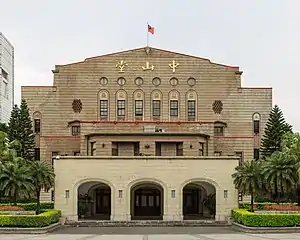 Chung-Shan Hall, located in downtown Taipei, meeting place of the National Assembly between 1950 and 1966. |
 Chung-Shan Building, located in the Yangmingshan region of Taipei, meeting place of the National Assembly from 1972 to its dissolution in 2005. |
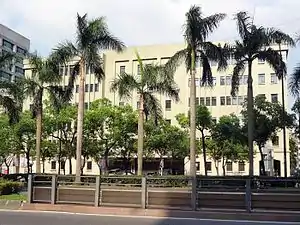 Secretariat building of the National Assembly, downtown Taipei. |
Constitutional reforms in the 1990s
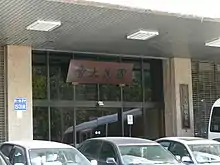
As a result of this decision, the same National Assembly, elected in 1947, remained for 44 years until 1991, when as part of a constitutional ruling a Second National Assembly was elected. There was strong objection to the Assembly, which was derisively called the "ten-thousand-year Congress" (萬年國會) by critics.
Shortly after passing constitutional reforms in 1991, the National Assembly held direct elections in December. Following a 1994 constitutional amendment, the Assembly essentially became a permanent constituent assembly, as the Assembly's other major role, to elect the President and Vice President of the Republic of China, was abolished. Direct elections for the president, vice president, and Assembly were held simultaneously in March 1996. Most of its other former functions, such as hearing the president's State of the Nation Address and approving the president's nominations of the grand justices and the heads of the Examination and Control Yuans, are now the functions of the Legislative Yuan.
In 1999, the Assembly passed constitutional amendments to extend terms of the Assembly and Legislative Yuan, which were strongly criticized by the public. The People First Party was founded shortly after the 2000 presidential election. The two larger parties, the Kuomintang and Democratic Progressive Party, wished to bar the People First Party (PFP) from the National Assembly. As a result, the 2000 National Assembly elections were canceled, and delegates were to be selected ad hoc on the basis of proportional representation via special election within six months of the Legislative Yuan proposing constitutional amendments, calling for the impeachment of the president or vice president, or declaring a vote on changes to national borders. However, no such situation arose from 2000 to 2004, and the National Assembly never met during this period.
Dissolution
On 23 August 2004, the Legislative Yuan proposed a series of amendments that included dissolution of the National Assembly. The purpose of this proposal is to transfer power to ratify constitutional amendments and territorial amendments from the National Assembly to the People. Under the amendments, subsequent proposed amendments are to be approved by three-fourths of the present members in the Legislative Yuan, with at least three-fourths of all members present. It would then be promulgated for a period of 180 days and then submitted to a referendum, in which a simple majority of all eligible voters shall be sufficient to ratify the amendments. A Democratic Progressive Party (DPP) proposal authorizing citizens initiative rights to propose constitutional amendments was withdrawn after it became clear that such a proposal would not pass the Legislative Yuan. Opponents of such constitutional reforms argued that by eliminating the 3/4 legislative vote requirement, a relatively small number of voters could force a referendum on Taiwan independence which would trigger a crisis with the People's Republic of China. By contrast, keeping the 3/4 legislative vote requirement would mean that any constitutional amendment would require a consensus among both the pan-green coalition and pan-blue coalition to be considered. The requirement that a majority of all voters approve the amendment allows for a party to block an amendment by boycotting the vote as was done with the referendums voted on alongside the March 2004 ROC Presidential elections.
Under the Constitution at the time, the National Assembly must then be elected to consider these amendments. Such consideration and eventual ratification of the constitutional amendments was originally considered to be a formality, but a number of unexpected complications occurred in 2005. The first was the poor showing of the People First Party (PFP) in the 2004 Legislative Yuan election. The PFP was widely expected to merge with the KMT, but PFP Chairman James Soong became disenchanted by the idea. The second was the reluctance of the Taiwan Solidarity Union to pass the amendments. These amendments were seen by some Taiwan independence supporters as a prelude to a later declaration of independence, but the results of the 2004 election made this very unlikely. Faced with this outcome, the TSU became very reluctant to support a reform that would make elections by small parties such as itself harder.
One final unexpected outcome occurred which gave the National Assembly elections on 14 May 2005 more significance than had been intended. The National Assembly election was lined up immediately after trips to mainland China by KMT Chairman Lien Chan and PFP Chairman James Soong. This had the effect of turning the May 14 elections into an opinion poll on relations with mainland China which was undesired by the Democratic Progressive Party, though the DPP subsequently gained a plurality in the elections.
.svg.png.webp) | ||||||
| Government | 249 | Opposition | 51 | |||
|---|---|---|---|---|---|---|
| Democratic Progressive Party | 127 | Taiwan Solidarity Union | 21 | |||
| Kuomintang | 117 | People First Party | 18 | |||
| Chinese People's Party | 3 | Democratic Action Coalition | 5 | |||
| Peasant Party | 1 | New Party | 3 | |||
| Civil Party | 1 | Non-Partisan Solidarity Union | 2 | |||
| Taiwan Independence Party | 1 | |||||
| Independent | 1 | |||||
| Endorse the constitutional amendment | Oppose the constitutional amendment | |||||
On 7 June 2005, the 300 delegates voted (by a majority of 249 to 48) the constitutional amendments into effect, and so dissolved the National Assembly until the "unification of the country" as stated in the preamble.[3]
Functions
The National Assembly held the most important constitutional powers within the national organs under the 1947 Constitution of the Republic of China. All of its powers were transferred to the Legislative Yuan and direct democracy exercised by the Taiwanese people after a series of constitutional amendments in the 1990s and early 2000s.
| Functions of the National Assembly under 1947 Constitution | Current implementation | |
|---|---|---|
| Article 4 | Ratify alteration of the national territory | Proposed by Legislative Yuan and ratified by Taiwanese people through a national referendum |
| Article 27 | Elect the President and the Vice President | Direct presidential elections by Taiwanese people |
| Recall the President and the Vice President | Proposed by Legislative Yuan and passed by Taiwanese people through a recall election | |
| Article 27 and Article 174 | Amend the Constitution | Proposed by Legislative Yuan and ratified by Taiwanese people through a national referendum |
| Ratify proposed Constitutional amendments from Legislative Yuan | ||
| Article 30 and Article 100 | Vote on impeachment of the President or the Vice President received from Control Yuan |
Proposed by Legislative Yuan and judged by the Justices of the Judicial Yuan in Constitutional Court |
The series of constitutional amendments coined the Additional Articles of the Constitution as the current basic law of Taiwan. During the evolution of the Additional Articles, the National Assembly also held the power to confirm some important governmental officers to maintain the separation of powers during the government reorganization.
| Office | Original Constitution (1947–1992) | Additional Articles (1992–2000) | Current implementation |
|---|---|---|---|
| Judicial Yuan | Leaders and members are nominated by the President and confirmed by the Control Yuan (Article 79) |
Leaders and members are nominated by the President and confirmed by the National Assembly |
Leaders and members are nominated by the President and confirmed by the Legislative Yuan |
| Examination Yuan | Leaders and members are nominated by the President and confirmed by the Control Yuan (Article 84) | ||
| Control Yuan | Members are elected by provincial legislators (Article 91) Leaders are elected by and from the members (Article 92) |
Elections and terms
The Kuomintang-led government of the Republic of China retreated to Taiwan in 1949, two years after the first election was held in China. As Kuomintang insists to claim the sovereignty over the whole China, the term of the members were extended until "re-election is possible in their original electoral district." In response to the increasing democracy movement in Taiwan, limited supplementary elections were held in Taiwan starting from 1969 and parts of Fujian from 1972. Members elected in these supplementary elections served together with the members who were elected in 1948. This situation remained until a Constitutional Court (Judicial Yuan) ruling on June 21, 1991 that ordered the retirement of all members with extended terms by the end of year 1991.[4]
| Term | Length | Actual served | Election | Seats | Note |
|---|---|---|---|---|---|
| 1st | Initially 6 years, then limit removed by Temporary Provisions | 1948—1991 | 1947 election | 2961 | The only election held in mainland China. 19 delegates were elected in Taiwan. 1578 delegates retreated to Taiwan with the government, 565 delegates served until the end of 1991. |
| 1969 supp | 15 | Elected in Taiwan, terms equal to the 1947-elected members | |||
| 1972 1st supp | 53 | Elected in the Free Area with 6-year term; then extended to 8 years. | |||
| 1980 2nd supp | 76 | Elected in the Free Area with 6-year term. | |||
| 1986 3rd supp | 84 | Elected in the Free Area with 6-year term, served until the end of 1992, overlapping with the 2nd assembly. | |||
| 2nd | Jan 1, 1992 to end of 8th President term | 1992—1995 | 1991 election | 325 | Total re-election in the Free Area |
| 3rd | 4 years | 1996—2000 | 1996 election | 334 | |
| ad hoc | 1 month | 2005 | 2005 election | 300 | Last election |
Timeline of National Assembly elections and terms

National Assembly sessions
| Term | Session | Date | Important decisions | Meeting Place | ||
|---|---|---|---|---|---|---|
| 1st | 1st | 1948 | Mar 29 – May 1 | Ratified the Temporary Provisions against the Communist Rebellion 1st presidential election (Chiang Kai-shek, Li Tsung-jen) |
National Great Hall | Nanking |
| 2nd | 1954 | Feb 19 – Mar 25 | Amended the Temporary Provisions, removed its expiration date Impeached Vice President Li Tsung-jen 2nd presidential election (Chiang Kai-shek, Chen Cheng) |
Chung-Shan Hall | Taipei | |
| 3rd | 1960 | Feb 20 – Mar 25 | Amended the Temporary Provisions, removed two-term limit of the President 3rd presidential election (Chiang Kai-shek, Chen Cheng) | |||
| interim | 1966 | Feb 1 – Feb 8 | Amended the Temporary Provisions, extended its power to create or review laws | |||
| 4th | 1966 | Feb 19 – Mar 25 | Amended the Temporary Provisions to perform limited legislative elections in Taiwan 4th presidential election (Chiang Kai-shek, Yen Chia-kan) | |||
| 5th | 1972 | Feb 20 – Mar 25 | Amended the Temporary Provisions, authorized President to reorganize central government 5th presidential election (Chiang Kai-shek, Yen Chia-kan) |
Chung-Shan Building | ||
| 6th | 1978 | Feb 19 – Mar 25 | 6th presidential election (Chiang Ching-kuo, Hsieh Tung-min) | |||
| 7th | 1984 | Feb 20 – Mar 25 | 7th presidential election (Chiang Ching-kuo, Lee Teng-hui) | |||
| 8th | 1990 | Feb 19 – Mar 30 | 8th presidential election (Lee Teng-hui, Lee Yuan-tsu) | |||
| 2nd interim | 1991 | Apr 8 – Apr 24 | Repealed the Temporary Provisions against the Communist Rebellion Ratified the Additional Articles of the Constitution (1st amendment) | |||
| 2nd | interim | 1992 | Mar 20 – May 30 | Amended the Additional Articles of the Constitution (2nd amendment) Renounced its right to elect the President | ||
| 2nd interim | 1992 | Dec 25 – Jan 30 | ||||
| 3rd interim | 1993 | Apr 9 – Apr 30 | ||||
| 4th interim | 1994 | May 2 – Sep 2 | Amended the Additional Articles of the Constitution (3rd amendment) Confirmed the President shall be directly elected by Taiwanese people since 1996 (9th) | |||
| 5th | 1995 | Jul 11 – Aug 17 | ||||
| 3rd | 1st | 1996 | Jul 7 – Aug 30 | |||
| 2nd | 1997 | May 5 – Jul 23 | Amended the Additional Articles of the Constitution (4th amendment) | |||
| 3rd | 1998 | Jul 21 – Aug 10 Dec 7 – Jan 25 | ||||
| 4th | 1999 | Jun 8 – Sep 3 | Amended the Additional Articles of the Constitution (5th amendment) (this amendment was then voided by the Judicial Yuan order) | |||
| 5th | 2000 | Apr 8 – May 19 | Amended the Additional Articles of the Constitution (6th amendment) Changed itself to an ad hoc constitutional convention | |||
| ad hoc | 1st | 2005 | May 30 – Jun 7 | Amended the Additional Articles of the Constitution (7th amendment) National Assembly abolished, and functions transferred to Legislative Yuan and national referendums. | ||
Leaders of the National Assembly
Secretary-general
When the Assembly is not in session, the secretary-general (Chinese: 秘書長; pinyin: Mìshūzhǎng; Pe̍h-ōe-jī: Pì-su-tiúⁿ) is the de facto highest-ranking official, in charge of the overall affairs of the Assembly and supervising its staff. Note that the secretary-general is entitled acting secretary-general when the National Assembly is not in session.
| No. | Name | Constituency | Term of Office | Political Party | Term | President | ||
|---|---|---|---|---|---|---|---|---|
| 1 | Hung Lan-yu | 洪蘭友 | Not a member | 22 November 1947 | 28 September 1958 | Kuomintang | 1st | Chiang Kai-shek |
| 2 | Ku Cheng-kang | 谷正綱 | Anshun, Guizhou | 15 December 1959 | 16 June 1966 | Kuomintang | ||
| 3 | Kuo Cheng | 郭澄 | Yangqu, Shanxi | 16 June 1966 | 10 June 1972 | Kuomintang | ||
| — | Chen Chien-chung | 陳建中 | Fuping, Shaanxi | 10 June 1972 | 20 September 1976 | Kuomintang | Chiang Kai-shek Yen Chia-kan | |
| 4 | Kuo Cheng | 郭澄 | Yangqu, Shanxi | 20 September 1976 | 29 September 1980 | Kuomintang | Yen Chia-kan Chiang Ching-kuo | |
| 5 | Ho Yi-wu | 何宜武 | Shouning, Fujian | October 1980 | September 1990 | Kuomintang | Chiang Ching-kuo Lee Teng-hui | |
| 6 | Chu Shih-lieh | 朱士烈 | Zhushan, Hubei | September 1990 | January 1992 | Kuomintang | Lee Teng-hui | |
| 7 | Chen Chin-jang | 陳金讓 | Party list | 31 January 1992 | September 1996 | Kuomintang | 2nd | Lee Teng-hui |
| 8 | Chen Chuan | 陳川 | Party list | September 1996 | 19 May 2003 | Kuomintang | 3rd | Lee Teng-hui Chen Shui-bian |
| — | Chien Lin Hui-chun | 錢林慧君 | Party list | 26 May 2005 | 31 May 2005 | Taiwan Solidarity Union | ad hoc | Chen Shui-bian |
| 9 | Yeh Jiunn-rong | 葉俊榮 | Party list | 31 May 2005 | 7 June 2005 | Democratic Progressive Party | ||
Presidium and Speaker
- The 1st and 2nd National Assemblies elected a presidium (Chinese: 主席團; pinyin: Zhǔxítuán; Pe̍h-ōe-jī: Chú-se̍k-thoân) as the leader of the body.
- The 3rd National Assembly elected a speaker (Chinese: 議長; pinyin: Yìzhǎng; Pe̍h-ōe-jī: Gī-tiúⁿ) and a deputy speaker (Chinese: 副議長; pinyin: Fùyìzhǎng; Pe̍h-ōe-jī: Hù-gī-tiúⁿ) to lead the assembly.
- The 2005 ad hoc National Assembly reverted to electing a presidium (Chinese: 主席團; pinyin: Zhǔxítuán; Pe̍h-ōe-jī: Chú-se̍k-thoân) as the leader of the body.
| No. | Session | Speaker | Deputy Speaker | President | ||||||
|---|---|---|---|---|---|---|---|---|---|---|
| Starts on | Ends on | Portrait | Name (Birth–Death) | Political Party | Portrait | Name (Birth–Death) | Political Party | |||
| 1 | 8 July 1996 | 13 January 1999 |  |
Fredrick Chien 錢復 (1935–) MNA for Nationwide KMT at-large №1 |
Kuomintang | 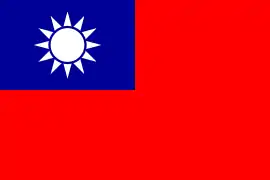 |
Hsieh Lung-sheng 謝隆盛 (1941–2006) MNA for Nationwide KMT at-large №3 |
Kuomintang | .jpg.webp) Lee Teng-hui (KMT) | |
| 2 | 13 January 1999 | 8 September 1999 |  |
Su Nan-cheng 蘇南成[note 1] (1936–2014) MNA for Nationwide KMT at-large №8 |
Kuomintang |  |
Chen Chin-jang 陳金讓 (1935–) MNA for Nationwide KMT at-large №2 |
Kuomintang | ||
| – | 8 September 1999 | 19 May 2000 |  |
Chen Chin-jang 陳金讓 (acting) (1935–) MNA for Nationwide KMT at-large №2 |
Kuomintang | Deputy Speaker served as the acting Speaker | ||||
The 2005 ad hoc National Assembly elected a presidium with 11 members as follows:
| Order | Name | Political Party | Order | Name | Political Party | |||
|---|---|---|---|---|---|---|---|---|
| 1 | Yeh Chu-lan | 葉菊蘭 | Democratic Progressive Party | 7 | Lee Yuan-chen | 李元貞 | Democratic Progressive Party | |
| 2 | Chen Chin-jang | 陳金讓 | Kuomintang | 8 | Nancy Chao | 趙麗雲 | Kuomintang | |
| 3 | Annie Lee | 李安妮 | Taiwan Solidarity Union | 9 | Hsu Chih-hsiung | 許志雄 | Democratic Progressive Party | |
| 4 | Yeh Yao-peng | 葉耀鵬 | People First | 10 | Ger Yeong-kuang | 葛永光 | Kuomintang | |
| 5 | Chou Ching-yu | 周清玉 | Democratic Progressive Party | 11 | Wellington Koo | 顧立雄 | Democratic Progressive Party | |
| 6 | Tsai Cheng-wen | 蔡政文 | Kuomintang | |||||
See also
Notes
- Resigned for forwarding a term-extension amendment, which was ruled unconstitutional by the Judicial Yuan.
References
External links
| Wikibooks has a book on the topic of: Annotated Republic of China Laws/Additional Articles of the Constitution of the Republic of China/Article 1 |
| Wikimedia Commons has media related to National Assembly (Republic of China). |
